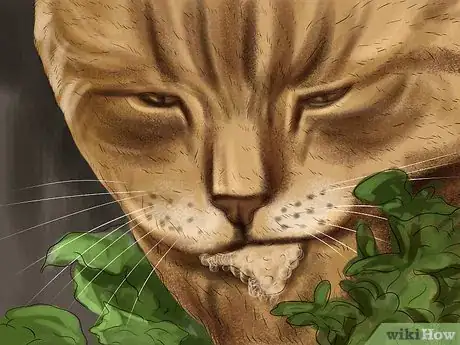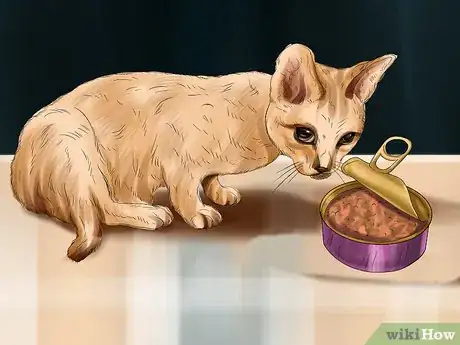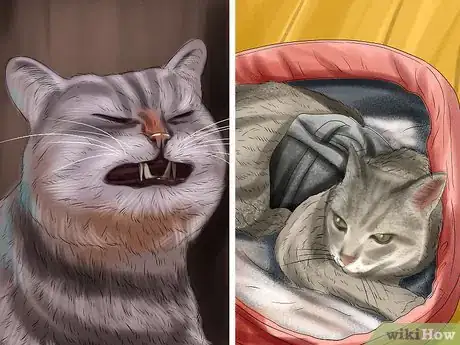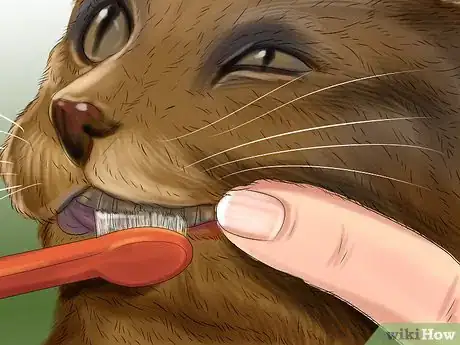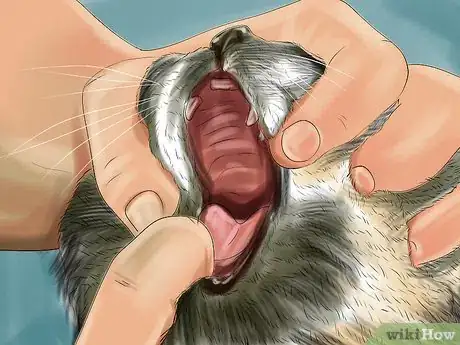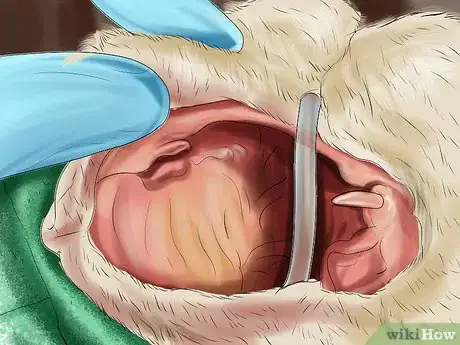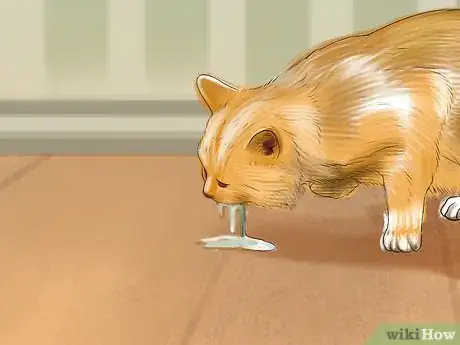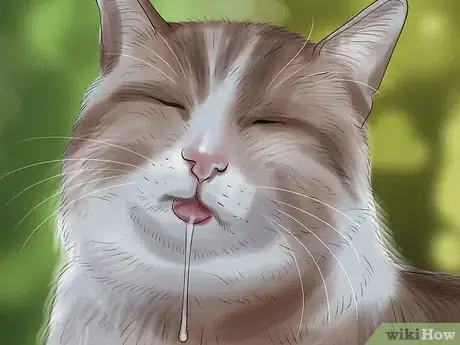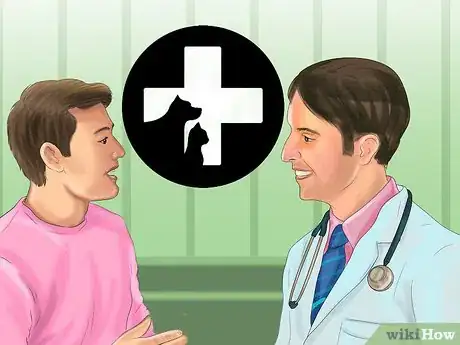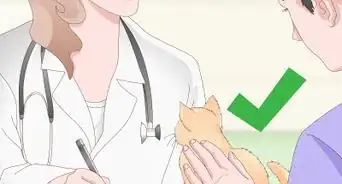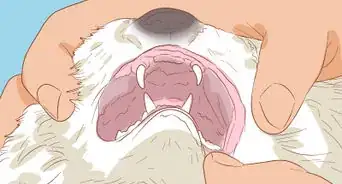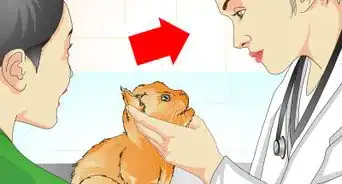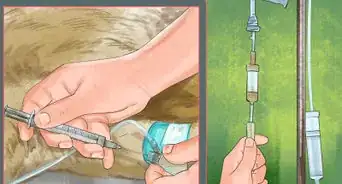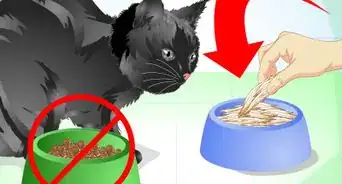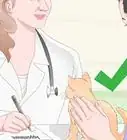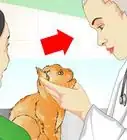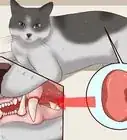This article was co-authored by Melissa Nelson, DVM, PhD. Dr. Nelson is a Veterinarian who specializes in Companion and Large Animal Medicine in Minnesota, where she has over 18 years of experience as a veterinarian in a rural clinic. She received her Doctor of Veterinary Medicine from the University of Minnesota in 1998.
There are 8 references cited in this article, which can be found at the bottom of the page.
This article has been viewed 60,265 times.
Cats drool for a number of reasons. Some of these reasons are benign and others may be a sign of a more serious health problem. Learn the difference between normal drooling and drooling that can be a sign of a more serious problem. Once you figure out why your cat is drooling, you can determine how you might be able to stop the drool.
Steps
Handling Common Causes of Drooling
-
1Anticipate happy drool. Cats often drool when they are happy and content, like when they eat catnip. Don’t give your cat catnip if you don’t want it to drool. Also feed your cat on time so it doesn’t drool when it’s happily waiting for food. And put a towel on your lap when you pet your cat, because you can’t prevent this type of happy drool.[1]
-
2Give your cat water or a little food when you administer medicine. Cats drool after eating bitter or unpleasant things, like medicine. Also distract your cat with toys or a ball of yarn after you apply topical flea or worming medication to try and prevent it from licking the medication off its fur. Treat your cat with food or water if it does lick any medication off.
- Bring your cat to the vet for medication and treatment if you notice your cat has symptoms like twitching, seizures, diarrhea, vomiting, not eating, and/or problems with its coordination after it licks topical medication off its fur.
- If your cat has to take a bitter medication long-term, then ask your veterinarian if it is possible to have the medication compounded so that it tastes better to your cat.
Advertisement -
3Avoid excessive travel if your cat gets motion sickness. Nausea can cause drooling in cats, but there are cat-friendly medications that can help with this. Ask your veterinarian about prescribing a medication to prevent nausea when you travel with your cat.
-
4Check with your cat’s veterinarian if your cat is frequently sick. If your cat is often drooling for no apparent reason and/or getting sick after drooling, then this may indicate a more serious problem. Take your cat to the vet if you note more serious symptoms, like loss of appetite, grinding teeth, or listlessness.[2]
- Check with the vet to be sure your cat’s nausea is not a sign of problems with the liver, kidneys, or pancreas, which will require immediate treatment.
- Your veterinarian can perform a physical examination, run blood tests to check for organ dysfunction that may be causing nausea, and do X-rays and/or an ultrasound.
Dealing with Dental Problems
-
1Identify and treat gingivitis. Check for signs of gingivitis or other gum disease, which can both cause drooling. These include swollen, red, or bleeding gums. Also check if your cat’s gums are receding or pulling away from its teeth. Treat the gingivitis or gum disease to stop drooling.[3]
- Brush your cat’s teeth regularly.
- Take your cat to the vet for a more thorough cleaning.
- Consult with your vet about possible tooth extraction.
- Get antibiotics for any infections in the gums.
- Look for signs of teething in your kitten. Teething also causes drooling.
-
2Find and remove any foreign objects in the mouth. Look for any foreign objects that might be lodged in your cat’s teeth or mouth and cause drooling. Also smell your cat’s breath because a foreign object lodged in the mouth for a long time can cause bad breath. You might also see that your cat is pawing at its mouth as though it’s trying to dislodge something stuck in there.
- Try to remove any objects stuck in the teeth or mouth.
- Bring your cat to the vet if you cannot remove foreign objects from the mouth.
-
3Take care of an abscessed tooth. Drooling and pawing at the mouth can indicate that your cat has an abscessed tooth. Look for other signs of an abscessed tooth, like loss of appetite, nosebleeds, sneezing, fever, less interest in playing and grooming, loose or discolored teeth. An abscessed tooth can also cause bad breath.[4]
- Have an abscessed tooth removed by your cat’s veterinarian. Your cat will be anesthetized during the procedure. The infection will also need to be treated with antibiotics, which your veterinarian can prescribe.
Finding and Treating More Serious Symptoms
-
1Keep your cat away from poisonous plants. Cats often drool as a sign that they have been poisoned. Check for other signs of poisoning, like not eating, twitching or seizures, diarrhea, vomiting, and mouth ulcers. Bring your cat to the vet immediately if you notice any of these symptoms in addition to the drooling.[5]
- Your vet can treat your cat with activated charcoal, by inducing vomiting, or even pumping your cat’s stomach.
-
2Ask your vet about kidney disease. Note if your cat is eating less and/or losing weight, urinating more often, and/or drinking more in addition to drooling. Also check for bad breath. If you see these symptoms, ask your vet to check your cat for kidney disease.[6]
- Request help changing your cat to a low protein diet to help with kidney disease prevention and treatment.
-
3Identify and treat an upper respiratory infection. Drooling can be a sign of an upper respiratory infection in your cat. Check to see if the drooling is accompanied by sneezing, discharge from the nose or eyes, and fever. Also, note if your cat is eating less. Treat the infection by encouraging your cat to eat and by keeping its eyes and nose clear.[7]
- Also, consult with the vet about other palliative care, which might include IVs to keep your cat hydrated.
-
4Consult with your vet about oral cancer. Drooling can be caused by mouth tumors and other cancers. Check with your vet if you notice ulcers in your cat’s mouth or other symptoms of oral cancer, which include swelling in the mouth, bad breath, and weight loss. Also report to your vet if your cat is reluctant to eat or to even close its mouth.[8]
References
- ↑ http://www.cathealth.com/how-and-why/why-do-cats-drool
- ↑ http://www.mnn.com/family/pets/blogs/why-do-cats-drool
- ↑ http://www.medicinenet.com/bleeding_gums/symptoms.htm
- ↑ https://www.vetary.com/cat/condition/dental-abscess
- ↑ http://www.petpoisonhelpline.com/uncategorized/top-five-feline-toxins/
- ↑ http://www.pethealthnetwork.com/cat-health/cat-diseases-conditions-a-z/why-do-cats-drool-its-never-normal
- ↑ http://www.cat-world.com.au/cat-drooling
- ↑ http://www.petful.com/pet-health/dont-ignore-drooling-cat/
About This Article
To stop your cat from drooling, keep in mind that some cats drool when they're happy, like when they're being pet or eating catnip, and it's nothing to worry about. However, if your cat often drools for no apparent reason, or if it gets sick after it drools, take it to the vet since there could be a more serious problem. Your vet can perform an exam and run tests to determine what's causing the drooling and how to make it stop. For more advice from our Veterinary co-author, like how to stop drooling that's related to dental issues, keep reading!
